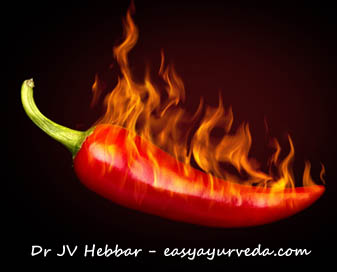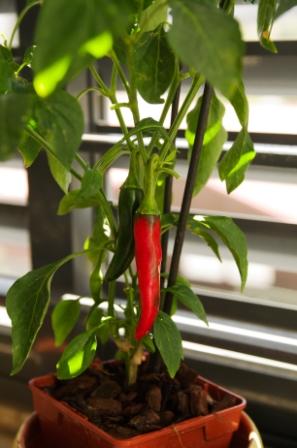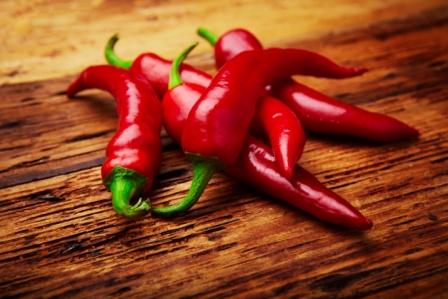Red Chilli – Capsicum annuum Uses, Research, Remedies, Side Effects
Capsicum annuum is commonly known as red chilli or bell pepper. It is used for the treatment of joint pain, anorexia, lack of appetite, fever, obesity etc.
Latin name- Capsicum annuum Linn.
Family- Solanaceae (Kantakari kula)

Table of Contents
Vernacular names
Bell pepper – Names in different languages:
Hindi name- Lal mirchi
English name- Red Chilly, Bell pepper
Bengali name- Lanka maricha
Kannada name- Menasinakai
Malayalam name- Molagu
Marathi name- Lal mirchi
Telugu name- Mircha kaya
Tamil name- Milagai
Sanskrit synonyms
Sanskrit names of Red chilli –
Katuveera- The seeds are pungent
Raktamaricha- The fruit is red in color
Pittakarini- Increases pitta dosha

Morphology
Morphology of Capsicum annuum:
It is a small herb found and cultivated all over India in the temperate climate. The plant grows to a height of 2- 3 feet with white colored flowers. The fruits are green while unripe and red after ripening. The seeds are flat and pungent in nature. Many varieties are cultivated for its commercial purpose and used for culinary purposes. Although the species name annuum means “annual”, the plant is not an annual and in the absence of winter frosts can survive several seasons and grow into a large perennial shrub. The plant is a native of Brazil.

Properties, part used, dosage
Medicinal Properties of Lanka / Katuveera:
Rasa (Taste) – Katu (Pungent)
Guna (Qualities) – Laghu (Light for digestion), Ruksha (Dry in nature), Teekshna (Strong)
Vipaka – – Katu (Undergoes Pungent taste after digestion)
Veerya (Potency) – Ushna (Hot)
Karma (Actions) – Kaphavata shamaka (reduces vitiated kapha and vata dosha), Pitta vardaka (Increases pitta dosha)
Part used- Fruit
Dosage- 30-60 mg
Chemical constituents
Chemical constituents of capsicum annuum:
Red chilly contains capsaicin (0.5– 1.5%), Capsorubin, Capsanthin, Rubixanthi carotenoids, flavonoids, volatile oil; steroidal saponins (capsicidins, only in seeds). Capsaicin stimulates the circulation and alters temperature regulation; topically desensitizes nerve endings and acts as a local analgesic. Vitamin P has been isolated from the chilies. Vitamin C gradually increases during maturation and reaches maximum at the semi-ripe or pink colored stage and decreases thereafter. The root contains Capsicosides C2, and C3
अरोचरेतः कफवातहारिणी विपाचिनी शोणितपित्तकारिणी ।
मेदोऽक्षिनिद्रोनलमान्ह्यहारिणी विसूचिकाम् कृन्तति पित्तकारिणी॥ (सि.भे.म)
Uses
Medicinal uses of red chilli:
- The paste of bell pepper is mixed with butter and applied over the joint area affected with pain and swelling.
- Small pills are prepared from the paste of the Bell pepper along with Camphor and Asafetida and given in the condition of cholera as part of treatment.
- The paste of the fruit of Capsicum annuum is applied with a paste of sandalwood over the forehead to treat headache
- The paste prepared from the fruit of Katuveera is applied over the area bitten by dogs to relieve pain and swelling.
- The powder of bell pepper is mixed with honey or sugar candy and taken in a dose of 3-5 g to relieve sore throat and improve the voice.
- The powder of the fruit is consumed in 2-3 g with buttermilk to improve the appetite and help in digestion.
- Regular intake of Katuveera in small quantities along with food as a spice additive can prevent clotting of blood and is beneficial in cardiac patients.
- The powder of red chilly and dried chilly is used as spice in many cuisines all over the world.
Traditional Uses
As per Siddha Bheshaja Manimala textbook,
Arochareta – useful in aruchi – anorexia
Vipachini – digestive, does ama pachana
Shonita pitta karini – causes Raktapitta – increases bleeding tendency
Medohara – decreases fat content
Akshihara – not good for eyes
Nidrahara – decreases sleep (due to pitta increasing effect)
Analamandya hara – relieves weak digestion. Improves digestion strength
Visuchikam kruntati – can cause diarrhea, vomiting
Pittakarini – Increases Pitta Dosha.
Side effect
Excess intake of Katuveera can cause ulcers in the stomach, oral cavity and hyper acidity.
Interaction with medicines, supplements
Can this be used while taking Homeopathic medicine?
Yes. This product does not react with homeopathic medicine.
Can this medicine be continued while taking supplements like multivitamin tablets, Omega 3 fatty acids etc?
Yes. Generally, this product goes well with most dietary supplements. However, if you are taking more than one product per day, please consult your doctor for an opinion.
With western
medicines
Seek your
doctor’s advice if you are taking this product along with other western
(allopathic / modern) medicines. Some Ayurvedic herbs can interact with modern
medicine.
If both Ayurvedic and allopathic medicines are advised together, then it is
best to take Allopathic medicine first, wait for 30 minutes and then take the
Ayurvedic medicine.
Ayurvedic medicines
Ayurvedic medicines containing Katuveera:
Dazzle ointment: Dazzle Ointment is a proprietary Ayurvedic medicine and it provides fast symptomatic relief. It is useful in joint pain, sprain and low back ache. It reduces pain, stiffness and muscle spasm and improves mobility by restoring range of motion.
Chesol oil: It is a proprietary Ayurvedic medicine useful for the treatment of rheumatic disorders as well as bronchitis.
Jointcare gel: It is a proprietary Ayurvedic medicine useful for the treatment of arthritis, spondylitis and musculoskeletal disorders.
Alopagesic liniment: It is a proprietary Ayurvedic medicine useful for the treatment of arthritis, localized swelling and pain.
Research
Research articles about Capsicum annuum:
Anti- oxidant potential: Nutritionally, sweet peppers are good source of mixture of antioxidants including ascorbic acid, carotenoids, flavonoids and polyphenols it is essential that compositional studies in plant food be carried out to take into account various factors such as cultivars, seasons and pre- and post-harvest conditions that may affect the chemical composition of plant foods.
Anti- inflammatory action: The ethanol and butanol extracts (200 mg/kg,) presented a significant anti-inflammatory activity toward the carrageenan-induced pleurisy model in mice in comparison to dexamethasone (0.5 mg/kg, s.c.). Among the parameters evaluated, the treatment with these samples inhibited leukocyte migration and reduced the formation of exudate. The contents of flavonoids and total phenolic compounds could be correlated with the antioxidant and anti-inflammatory activities observed for Capsicum baccatum.
Scientific classification
Kingdom: Plantae
Order: Solanales
Family: Solanaceae
Genus: Capsicum
Species: C. annuum
Author:
Dr.B.K.Prashanth M.D (Ayu), Ph.D
E mail: [email protected]
Q: Chilli is hot in nature. Why do people living in North Karnataka, where temperature soars up to 45 degree Celsius, eat chili?
Answer by Dr Hebbar:
We cannot judge its heating or cooling activities just by the fact that it is eaten in hot places. North Karnataka people eat raw chili along with parota / Rothi or Chapati. That does not mean chili is cooling.
During summer, digestion strength will be weak as the body heat lies mostly externally in the limbs and it is low in the digestive tract. This is why, it is explained that Agni is low during Greeshma ritu – where Pitta is receding and Vata is slowly increasing.
So, people working under hot sun usually drink a lot of water. So, Agni weakens further. To counter that, they may eat more chili.
Spices, chili powder
Rasa – pungent
Guna – light, dry, piercing, sharp
Veerya – hot
Vipaka – pungent
Effect on Doshas
Vata balancing
Pitta increasing
Kapha balancing
Variants of Peppers
Peppers, hot chile, sun-dried
Taste – pungent, sour, bitter
Properties – heavy (as it is dried)
Potency – hot
After digestion taste transformation ( Vipaka ) – pungent
Effect on Doshas
Vata balancing
Pitta increasing
Kapha balancing
Pepper, banana, raw
Taste – sour
Properties – light
Potency – hot
After digestion taste transformation ( Vipaka ) – sour
Effect on Doshas
Vata balancing (helps to maintain bone health)
Pitta increasing (promotes blood pressure, digestion, blood circulation)
Kapha balancing (used to prevent cancer)
Peppers, serrano, raw
Taste – pungent, bitter
Properties – light
Potency – hot (digestive)
After digestion taste transformation ( Vipaka ) – pungent
Effect on Doshas
Vata balancing (relief from sore muscles, arthritis pain)
Pitta increasing (causes sweating)
Kapha balancing (maintains cholesterol)
Peppers, ancho, dried
Taste – pungent, bitter
Properties – heavy (raw form poblano is light = helps lose weight)
Potency – hot
After digestion taste transformation ( Vipaka ) – pungent
Effect on Doshas
Vata balancing (has analgesic effect)
Pitta increasing
Kapha increasing (due to high nutrient concentration in dried form) (raw form, poblano is Kapha balancing (fights cancer)
Peppers, jalapeno, raw
Taste – pungent, bitter
Properties – light (can promote weight loss), dry (reduce abdominal fat)
Potency – hot (boosts metabolism)
After digestion taste transformation ( Vipaka ) – pungent
Effect on Doshas
Vata balancing (natural pain reliever)
Pitta increasing (due to hot potency and pungent taste)
Kapha balancing (promote weight loss)
Peppers, chili, green, canned
Taste – pungent
Properties – light, dry, sharp, piercing
Potency – hot
After digestion taste transformation ( Vipaka ) – pungent
Effect on Doshas
Vata balancing
Pitta increasing
Kapha balancing
Peppers, hungarian, raw
Taste – sour, sweet, pungent
Properties – light
Potency – hot
After digestion taste transformation ( Vipaka ) – pungent
Effect on Doshas
Vata balancing
Pitta increasing
Kapha balancing
Peppers, pasilla, dried
Taste – pungent, bitter
Properties – heavy (raw form is light = helps lose weight)
Potency – hot
After digestion taste transformation ( Vipaka ) – pungent
Effect on Doshas
Vata balancing (has analgesic effect)
Pitta increasing
Kapha increasing (due to high nutrient concentration in dried form) (raw form is Kapha balancing (fights cancer)
Sthanika Karma (Systemic Action)
External – It has a scraping action on the body tissue. External application of the paste is indicated in Kaphaja type of headache, Rheumatoid Arthritis, Low back pain, Pain in the flanks, etc. Paste and gargling with its decoction is used in Throat infections. It has an Anti poisonous effect. Oil prepared with Mustard oil is indicated in skin disorders
Nervous System – Pacifies vata dosha, induces sleep, and is indicated in joint disorders , Alcoholic intoxication etc.
Digestive System – Stimulate salivary glands, Carminative, Digestive, Facilitate normal movement of doshas,.indicated in Anorexia, loss of appetite, Abdominal distension etc. Tablets prepared with Asafetida, capsicum and Camphor can be taken in Dysentery. Overdose can cause Burning sensation.
Circulatory System – Cardiac stimulant
Excretory system – Increases urine production, Therapeutically it is used in Dysuria
Reproductive system – Aphrodisiac
Tapakrama – Antipyretic (Vishamajvara pratibadhaka, Also indicated in Santata jvara and in Sannipata jvara)
Satmikarana – Dhatunasaka (Scraping action on the tissues) Indicated in obesity and related disorders)











7 comments
Bhadresh Jadhav
Why we can’t find any Shastriy aushadhi in ayurveda with red chilli. ?
Satyan Namdhari
Red chilli (cayenne pepper or paprika) has different taste and qualities than bell pepper, even though both seem to have same scientific name. Red chilly contains capsaicin. Bell pepper or Shimla Mirch does not contain capsaicin. Bell pepper can be eaten raw in salad without burning sensation. Red chillis cause intense burning sensation. All medicinal properties are referring to red chillis that are long and not bell shaped.
Deepak
Chilli was introduced in India by the portuguese in 15th century, how come it has crept in to Ayurveda which is several thousand years old?
Dr J V Hebbar MD(Ayu)Author
There are many Ayurvedic text books that are written after 15th century. When foreign traders and intellectuals were visiting India, there were exchanges in terms of cultural values, common terms used in speaking different languages, spices and herbal knowledge.
Alexander
Dear Sir, what does it mean: “अरोचरेतः कफवातहारिणी विपाचिनी शोणितपित्तकारिणी ।
मेदोऽक्षिनिद्रोनलमान्ह्यहारिणी विसूचिकाम् कृन्तति पित्तकारिणी॥ (सि.भे.म)”?
arocaretaḥ (?) kaphavātahāriṇī (reduce kapha and vata) vipācinī (digestive?) śoṇitapittakāriṇī (tends to piles)।
medo’kṣinidronalamānhyahāriṇī (?) visūcikām (?) kr̥ntati (helps with cholera) pittakāriṇī (increases pitta)॥ (si.bhe.ma).
Can we translate it?
Dr J V Hebbar MD(Ayu)Author
Arochareta – useful in aruchi – anorexia
Vipachini – digestive, does ama pachana
Shonita pitta karini – causes Raktapitta – increases bleeding tendency
Medohara – decreases fat content
Akshihara – not good for eyes
Nidrahara – decreases sleep (due to pitta increasing effect)
Analamandya hara – relieves weak digestion. Improves digestion strength
Visuchikam kruntati – can cause diarrhea, vomiting
Pittakarini – Increases Pitta Dosha.
Alexander
Thank you very much, sir!